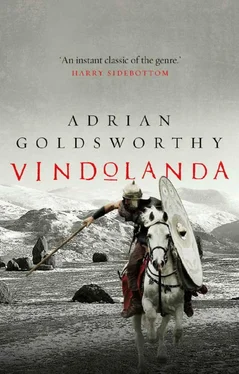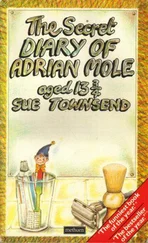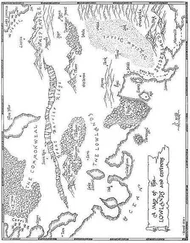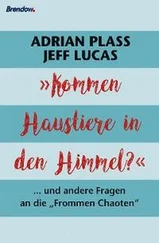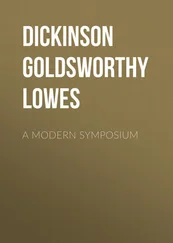There are references to children in the households of commanders, and Cerialis appears to have had at least three. However, no letter specifically names Sulpicia Lepidina as their mother, so that I was able to make them offspring from an earlier marriage even though this is pure fiction. Shoes found associated with the praetorium from this period are of such high quality that they surely belong to the prefect’s family. This suggests that there were two boys and a girl, the older boy’s shoes wearing out in a strange pattern that may well indicate some physical disability, albeit one that did not prevent him from walking. Among the shoes likely to have belonged to Sulpicia Lepidina is one slipper that would not be out of place in a shop window today. On the whole the footwear from Vindolanda consists of enclosed shoes rather than the sandals we automatically associate with the Romans. Judging from finds of similar styles elsewhere, patterns in footwear changed throughout the empire every couple of decades. It is also clear than the majority of people owned more than one pair – something rare until the modern era.
Tribes and Druids
Iron Age Britain was occupied by many different tribes and other groups, many of them only ever mentioned in Roman sources. It is likely that Roman and Greek observers misunderstood many aspects of the indigenous population’s sense of identity, but we have little more to go on. All of the groups mentioned in the book lived in the areas described, and as far as we can tell all shared a version of the same language. These days, some archaeologists are reluctant to use terms like Celtic or to assume that this linguistic group shared a common culture, and therefore that traits described in Gaul or elsewhere were also likely in Britain. This approach can be too dogmatic, and as a novelist I have drawn upon evidence from other regions as well as cultures from other lands and other periods to create a picture of the tribes. I have done my best to make sure that none of this material conflicts with what we do know.
Judging from the environmental evidence, in AD 98 the climate in the north was a little milder than it is today, closer to that of south-east England. This may well have changed and grown colder during the second century. There is evidence for widespread cultivation as well as pastoral activities. Several sections of Hadrian’s Wall were built on ploughed land. The population was considerable and this was far from being a wasteland, but most people lived in small settlements, often a few huts on their own, with larger villages and hill forts much less common. In spite of some attempts by scholars to pacify Iron Age Britain, all the evidence points to societies in which warfare, usually in the form of raiding, was an ever-present threat. This is true of most of the ancient world. The Roman Empire imposed on a large chunk of the world a much higher level of peace than it had ever enjoyed before. The famous Pax Romana was real, but it was maintained by force, and in some areas, especially near the frontiers, it was far from unbroken by outbursts of violence and warfare.
Archaeology is not well suited to charting political change among Iron Age peoples. Tincommius and his growing empire are both inventions. There is no evidence as yet for the appearance of so powerful a leader in this region, or for any reuse of an abandoned and slighted Roman fort in the way described in the story. However, his career so far and in the stories to come is based on similar charismatic leaders who appeared at other times in the lands around the empire. At the close of the first century AD, most observers in northern Britain would have surely seen the Romans as in retreat. In such circumstances, other forces quickly emerge to fill the power vacuum.
The druids have attracted a good deal of interest over the centuries, most of it highly romantic. Julius Caesar depicts them as important figures in the Gaul of his day, acting above and outside the tribes. He does not portray them as anti-Roman or as able to control the tribes. Under Augustus and the other emperors the druidic cult in Gaul was restricted and later suppressed, although it survived covertly. In Britain the Romans attacked the centre of the cult in AD 60, invading the island of Mona (or Anglesey) and destroying the sacred groves there. This does appear to have ended the formal structure of the druidic cult. In spite of this people called druids appear in Gaul and Britain in the centuries to come, but lack the status of the aristocratic priests of earlier years.
Conquest and occupation by an imperial power has often caused serious dislocation to the society and beliefs of indigenous peoples, and it is tempting to see the periodic appearance of druids with apocalyptic prophecies as similar to religious movements in more recent times. Among the most famous are the various Ghost Dance movements in North America in the late nineteenth century, but other examples include the various mystics who appeared among the Xhosa in South Africa, or what was popularly known as the Hauhau movement among the Maori. Very often, such leaders preached a mixture of imported beliefs alongside traditional ideas. This is the basis for the story, and I have presented the Stallion’s followers as using a mishmash of magical words and invocations, as well as Greco-Roman deities alongside old beliefs and gods.
The Silures lived in what is now South Wales. Tacitus described them as darker and different in appearance from other Britons. They first came into conflict with the Romans in the late forties AD, and were keen supporters of Caratacus, the leader from the south-east who kept fighting the invaders for years after his homeland was overrun. The Silures were known for raiding their neighbours, and exploited the hills and valleys of their homeland, using stealth, surprise and ambush in their long struggle against the Romans. It took at least twenty-five years to defeat them and substantial Roman garrisons remained in the area for some time. Ferox and his grandfather are fictional, but it was common practice to take hostages from defeated leaders, educating them within the empire. Many became Roman citizens and served in the army, so there is nothing implausible about Ferox and his career.
The Roman Army
This is a vast subject, but it is worth making a few points for those new to the topic. In AD 98 the Roman army consisted of twenty-eight legions – two more would soon be added by Trajan – each with a paper strength of some 5,000 men. Each one was divided into ten cohorts of heavy infantry and had a small contingent of some 120 horsemen. Legionaries were Roman citizens. This was a legal status without any ethnic basis and by this time there were over four million Roman citizens scattered throughout the empire. We may think of St Paul, a Jew from Tarsus in Asia Minor, but a Roman citizen and entitled to all the legal advantages that brought.
Supporting the legions were the auxiliaries who were not citizens, but received citizenship at the end of their military service. These were organised as independent cohorts of infantry and similarly sized cohorts of cavalry. There were also the mixed cohorts ( cohortes equitatae ) like the Batavians, which included both infantry and cavalry in a four to one ratio. Legionaries and auxiliaries alike served for twenty-five years. Most were volunteers, although conscription did occur and was probably especially common with some auxiliary units.
We know a good deal about the Roman army, about its equipment, organisation, command structure, tactics, ranks and routine, although it must be emphasised that there are also many gaps in our knowledge. As a historian it is my duty to stress what we do not know, but a novelist cannot do this and must invent in order to fill in these gaps. Some aspects of the depiction of the Roman army in this book may surprise some readers, but often this will be because some of the evidence for it is not well known outside academic circles. I have invented as little as possible, and always done my best to base it on what we do know. As an introduction to the army, I am vain enough to recommend my own The Complete Roman Army published by Thames and Hudson. I would also say that anything by the late Peter Connolly is also well worth a look. Once again, for more specific recommendations, I refer readers to my website.
Читать дальше
